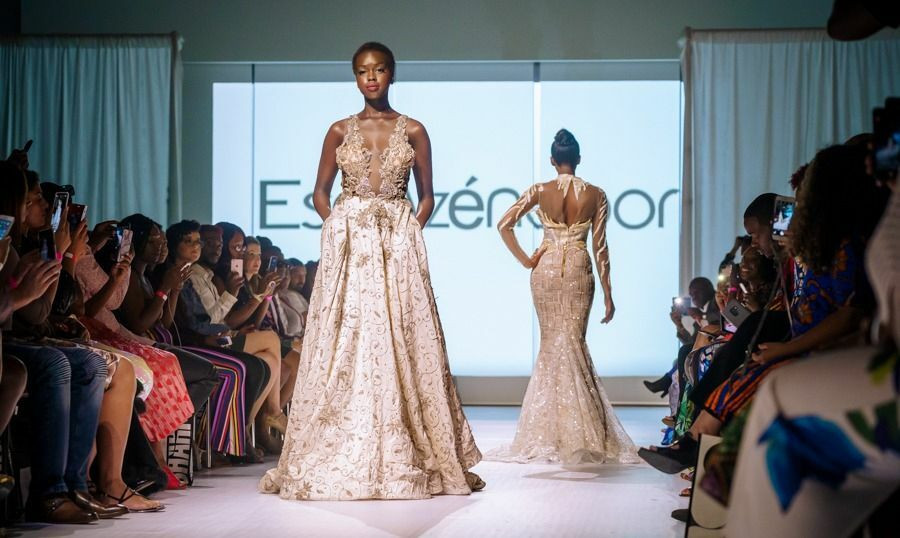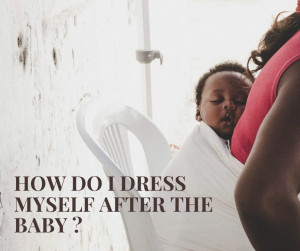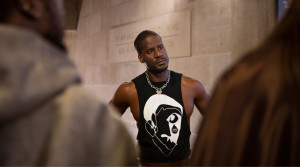This was a prophecy of sorts where he warned that the things that gave us comfort would be drastically disturbed. The discomfort, though temporary, would be necessary for things to be put in order. When the pandemic hit we were in the throes of civil unrest, with the world figuratively and literally on fire. With Flow's words in mind, 2020 seems to be the year we are putting our society, and ourselves, under the microscope. We’re discovering in many ways what we’re made of.
Examining these revelations as it pertains to fashion is particularly interesting, as along with most arts, fashion both influences and is influenced by society. The beautiful and the grotesque coexist in the world of art. We give microaggressions a pass and somehow find classism acceptable. But through the advent of social media activism, many brands are now being held accountable for their racist, bigoted, exploitative and exclusionary practices. The catchphrase “diversity and inclusion” has become this year’s marketing buzzwords, with many organizations simply placing Black and Brown faces in front of unchanged policies.
The Fashion and Race Database, in partnership with Holt Renfrew's H Project, hosted a conversation series called, “Retail as a Portal: The Way Forward to Systemic Change” with Robin Givhan, 2006 Pulitzer Prize Winner and critic-at-large for the Daily Beast, and Sherri McMullen, former buyer for Neiman Marcus and owner of McMullen Boutique.
The Fashion and Race Database is an organization created and directed by Assistant Professor of Fashion Studies at Ryerson University, Kimberly Jenkins. The goal of the database is to “center and amplify BIPOC (Black, Indigenous, People of Color) fashion scholarship, illuminate under-examined histories and address racism throughout the fashion system.” Robin Givhan started off as a Generalist at the Detroit Free Press; a fellow writer’s resignation created an opportunity to enter the fashion realm. She primarily covered men’s fashion, later becoming the fashion editor of the Washington Post. Sherri McMullen began her career in the fashion industry as a buyer. Using her degree in business and accounting, she worked her way up the ranks at Neiman Marcus, later leaving the company to launch her own boutique in 2007.
The following is based on the discussion that took place during the series...
BLACK IN THE INDUSTRY
Getting into the fashion industry is challenging. If the film The Devil Wears Prada taught us anything, it’s that there’s a lot of grunt work in even the most luxurious of spaces. Most of us engage with fashion from the retail end, stacking our wish lists as we drool over the pages of magazines. How to break through is the question on every fashion hopeful’s mind. Sherri McMullen told a story all too familiar, not just of the fashion industry, but for most corporate jobs in North America. It's the story of being the only one, or one of the few, Black people in an industry with a notable absence of Black and other persons of colour in decision-making positions. Although being undoubtedly qualified, she expressed the challenges of trying to move up the ladder while being passed up for promotions, which is what drove her to create McMullen Boutique. The boutique was an opportunity to create a space for herself, and people like her.
“Black youth need to see themselves in this luxury space that for so long has felt incredibly exclusive,” McMullen asserted. “Breaking into an industry you don’t entirely understand feels impossible.” Being from Oklahoma, outside of working retail and designers, McMullen wasn’t sure what else existed for her. When asked about her journey to opening her boutique, McMullen stressed the importance of learning on a company’s dime and time. “Work for a larger company for a few years, make mistakes and understand the process,” McMullen advised. McMullen placed responsibility for engaging young up-and-coming talent squarely on industry leaders, and encouraged BIPOC people with a desire to enter fashion to investigate training programs offered by companies. She also pointed out how her business and accounting degree has helped her in her entrepreneurial pursuits. “Being an entrepreneur is about your gut, but you need to know how to read a P&L (profit and loss statement) and make smart decisions,” McMullen adds.
Kimberly Jenkins, the moderator of the discussion, tackled the recurrent excuse presented as a conundrum whenever the lack of diversity in executive spaces is challenged...where does one find the talent? As is evident to anyone paying attention, there’s no lack of brilliant and capable Black people. “Talent is everywhere,” remarked Jenkins. “The real question is, where are you looking?” Charlie Scharf, CEO of Wells Fargo, came under fire this summer for his weak explanation for the lack of diversity within the company claiming, “the pool of Black talent is limited.” I believe this to be false, and that the main reason corporations have very white executive boards is they refuse to make inclusion a priority. Mining new areas for young talent that can be mentored, and conducting outreach and information campaigns to diverse communities, are just a few ways to address the incredibly damaging bias held by corporate gatekeepers and key decision-makers. Whether Wells Fargo or Vogue, the solutions do exist.
Writing is another avenue into the fashion industry as exemplified by Robin Givhan’s career. Givhan shared a few key tips to keep in mind. “Most newspapers have a dedicated fashion writer,” Givhan said, “and this is often a pipeline into the industry.” Other gems included, “Newspapers, unlike magazines, have paid internships, which makes it more accessible to a wider pool of talent.” It also turns out, location isn’t everything. “Fashion magazines are largely based in New York City,” Givhan pointed out. “There is a very small percentage of individuals that can afford to live in New York City for a summer and work for free.” Givhan’s suggestion to those hiring in the fashion industry? “Look through publications where you admire the strength of someone’s perspective, their voice, editing, writing, creative directors...the people who feed into the fashion world and have a great aesthetic eye.” Givhan suggested seeking out those with the skills you need, that may not have been applied specifically to fashion.
RACE ON THE RUNWAY
During the conversation, Kimberly Jenkins brought attention to the stark variance in representation of Black people in fashion between the 70s, 80s and 90s. Robin Givhan suggested the decline in funding for the arts in public schools was a huge contributing factor. “Art teachers were often the catalyst for young people, directing them to explore the possibilities of entering the field of design,” Givhan theorized. “Moreover, fashion became quickly dominated by European conglomerates, which in turn resulted in a very homogenous runway.” This exclusion of Black people in these large fashion houses, gave way to young Black designers creating their own, which introduced the rise of what is often referred to as “urban” or “street” wear of the 1990s and early 2000s.
As a buyer, Sherri McMullen expresses the huge role gatekeepers play in accessing up-and-coming designers. “Relying heavily on showrooms means buyers can only get what the showrooms give, so it’s rare to see Black designers prominently placed,” Mcmullen said. “The consolidation of department stores has limited the ability of buyers to source new designers and reduces the space to take risks.” However, McMullen still utilizes social media to connect with fresh brands to feature in McMullen and praises the platform for being “a game-changer.” Social media has allowed Black designers to broadcast their designs and aesthetics to a global audience. Consequently, larger non-Black owned brands who have been exclusionary of Black people in the past are capitalizing on the immense popularity of Black culture. These same brands now stand accused of appropriating Black culture. “What would have gone overlooked in decades past, is now being called out due to social media,” Givhan said. "The damage the outrage may cause rarely has lasting effects on the brands, but it has certainly made it clear how easy it can be to avoid these fumbles by simply engaging and empowering Black people to be a part of your decision-making team."
BLACK ≠ URBAN
“It sucks that whenever we — and I mean guys that look like me — do anything that's genre-bending or that's anything, they always put it in a rap or urban category. I don't like that 'urban' word — it's just a politically correct way to say the n-word to me.”
-Tyler The Creator
Tropes are incredibly reductive. Being a part of a marginalized group often means dealing with limiting ideas of who you are every day. There are countless think pieces dissecting the impact of microaggressions in the workplace, industry and institutions. Urban and Black are not synonyms regardless of how many times the two are conflated. Creative industries are an arena where works created by Black people are limited to the peculiar category of “urban”...be it music, dance, visual art or fashion. Robin Givhan told a story of an interview she did with Sean “P-Diddy” Combs in which he shared the challenges of breaking through the “urban” category barrier. He had an entire collection of suits going down the runway but was still categorized as urban-streetwear, even though t-shirts were a thing of his past. Kimberley Jenkins offered her perspective as a Black educator, calling the categorization insidious and pervasive. “Even entering the industry from the side of academia you’re being pigeon-holed into teaching urban or streetwear design,” laments Jenkins. “We are so much more than that.”
CONSCIOUS CONSUMERS
Consumers are far more engaged with the buying process than ever before. With more options and access to information, a brand’s story matters. “People want to buy things that make them feel good,” Sherri McMullen said. “People want to support brands that have a purpose, align with their values and are intentional about how they spend their dollar.” The events of 2020 (BLM and Covid) have really energized movements, with a growing demand to support Black businesses, women and persons of color-led brands, as well as brands that are inclusive. Black businesses by all measures have suffered disproportionately during the pandemic. Despite government-led programs for funding, there are still systemic barriers to accessing that money. Sadly, the targeted outreach to Black business owners in Canada is simply not there.
Despite these challenges, through grassroots efforts, viral social media campaigns, and online communities and networks, many brands have flourished during this time. Still, McMullen offered this grounded warning. “We need to support these businesses in sustaining their growth and meeting the rising demand.” On a larger scale, Robin Givhan discussed the impact the call for diversity has had on large fashion houses. “Initially, the focus was primarily on the runway and having more people of colour modelling the clothing and in advertising,” Givhan stated. “Fortunately, the focus has begun to broaden and corporations have been pushed to examine who is sitting in the boardroom seats, and whose products make it onto store shelves.”
2020 has brought us a lot in the way of challenges and opportunities. However, there are certain fights that have been raging long before this year that have undoubtedly reached a boiling point. During this summer, as a sign of solidarity with Black Lives Matter, various brands posted a black square on their Instagram pages. They jumped on Twitter, some after being exposed for their many transgressions, tweeting promises to listen and learn. Resoundingly, Black folks expressed feelings of exhaustion; weary from the emotional toll of mourning the loss of Black lives, compounded by the psychological labour required to educate those that have remained willfully ignorant. The trauma seemed unrelenting. We’ve lined up to transform industries from within in a bid to make them more inclusive and reflective of the population. However, this strategy has offered little reward for Black creatives, resulting in many stepping out of the line to create industries of their own.

 By
By 





